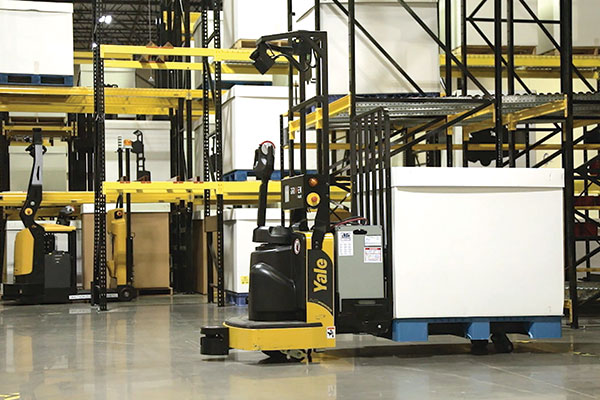High-tech innovations, like fully autonomous electric lift trucks, can help lift truck fleets be more effective in this era of rap...
![]()
High-tech innovations, like fully autonomous electric lift trucks, can help lift truck fleets be more effective in this era of rapidly growing e-commercefulfillment. And lower-tech features, such as special attachments, can help companies get the most throughput out of their lift truck fleets, which for indoor warehousing, means electric trucks.
It all comes back to getting more order fulfillment work done accurately and safely, while reducing dependency on a shrinking, turnover-prone workforce, according to Mike Kennedy, executive business manager for Yale Materials Handling Corp., which offers a range of lift trucks.
“E-commerce is changing the world, along with customer expectations about rapid, accurate order fulfillment,” says Kennedy. “This creates a challenge for operations, because you have these high expectations from customers, and yet all these goods need to be moved and handled accurately as part of that, at a time when companies are struggling to find and maintain a consistent workforce. These pressures really increase the need for more throughput and picking speed with a lift truck fleet, and also for accuracy in order picking activity. Accuracy is the utmost importance, along with throughput, for today’s commerce, because customers expect a completely accurate order.”
When it comes to lift trucks, some advanced technologies can help meet these challenges, notes Kennedy, including:
Autonomous lift trucks that can also be operated in manual mode (a “dual-mode” autonomous truck), to allow for full automation of certain repetitive processes, but still allow for flexible use by human operators when needed.
Technology integration can contribute to safe operation while allowing operators to stay focused on materials handing tasks. For example, remote order picking technology integrates with warehouse management system (WMS) data on pick tasks to automatically advance a lift truck to the next pick position. This can help with throughput in low-level order picking by allowing the operator to stay on foot in a good position to execute picking and placing tasks, without having to constantly return to the operator compartment to advance the truck. Similarly, voice-directed solutions that integrate with a WMS can be used by lift truck operators to speed up certain workflows.
The particular mix of trucks or technologies an operation needs to keep up with throughput requirements will vary, says Kennedy, but it isn’t always centered on acquiring robotic, autonomous trucks or even trucks with the latest in operator assist features.
Sometimes major productivity enhancers are lower tech in nature and can be identified in assessment sessions with lift truck providers to match the solution to site-specific needs or functional gaps.
“No one customer is alike, so it’s not possible to have a cookie-cutter approach and just replicate that with every lift truck fleet or operation,” says Kennedy. “That said, we do see an increasing need for order picker models, and more use of special attachments that help with productivity in order selection tasks.”
Yale, Kennedy explains, has worked with customers to develop specialized basket attachments for order pickers. These help with productivity because the operator has a convenient, basket-like location to place product in an organized way to fill specific orders, or batch pick for later consolidation. Kennedy says Yale has worked with multiple e-commerce and retail companies to develop such basket-like attachment for order pickers.
Another valuable type of attachment is a layer picker attachment, which allows a lift truck operator to rapidly create mixed-SKU pallets by using the attachment to grasp, move and place an entire layer of cases onto a position significantly faster than having workers build mixed pallets by hand. For another client, says Kennedy, a key improvement was the creation of extra-long forks (144 inches long), which allow the fleet’s electric, enclosed end rider pallet jack models to move multiple pallets at once, increasing throughput.
Sometimes the maximum benefit comes from combining something low-tech, like basket attachments, with a technology like wireless remote advance, to gain the maximum throughput.
An assessment session, which Yale refers to as a “blueprint” session, can identify the mix of lift truck models, technology features, attachments, or rack and layout changes that will provide the greatest benefits.
For example, it may be that an operation could benefit from more order picker units, and a tweak to racking to allow for two levels of product to pick from, with the fastest movers on the ground level and medium movers on a second level.
“Often times, it’s these collaborative blueprint sessions with the customer that will identify the mix of technologies, products or other changes, that will increase productivity for a particular operation,” says Kennedy.
Kennedy does see growth for autonomous lift trucks, as user companies face the prospect of higher volumes and increasingly hard to find operators. A dual-mode autonomous model, Kennedy says, offers the flexibility to operate as a regular truck, when needed, though payback is typically based on full automation of specific pallet movement workflows for busy, multi-shift sites.
“They do cost more than a manual equivalent, but for operations with two shifts or more, the payback is typically two years or less, so they are another option to consider for many sites,” says Kennedy.
Just don’t forget the lower-tech aspects of enabling greater productivity from an electric lift truck fleet, says Kennedy, such as working with dealers or OEMs on attachments, or seeking advice on how to set up an efficient low-level order picking operation, or a layer picking area. Together with trucks suited to specific tasks, and of course the operators, these elements constitute a system aimed at accuracy, productivity and safety.







 粤公网安备 44010602003952号
粤公网安备 44010602003952号